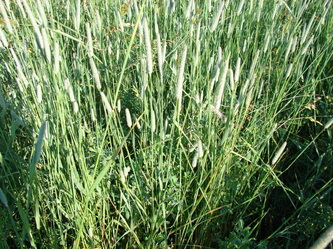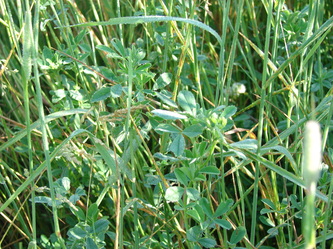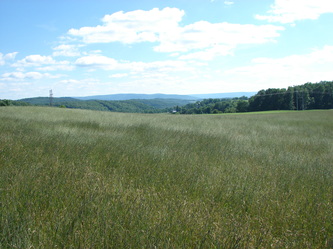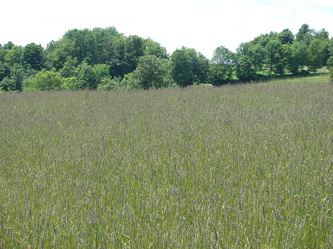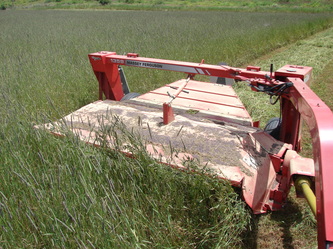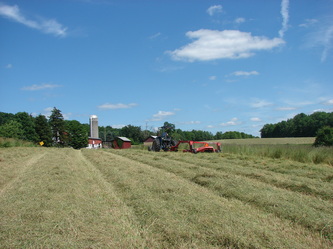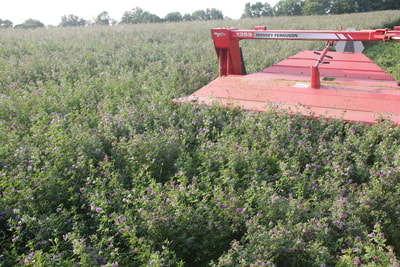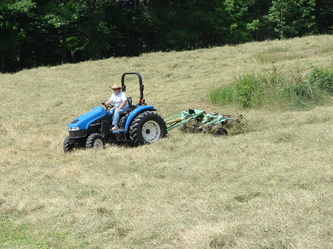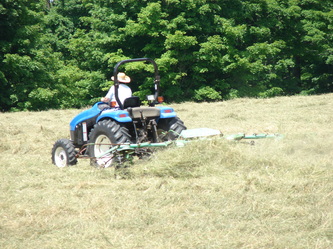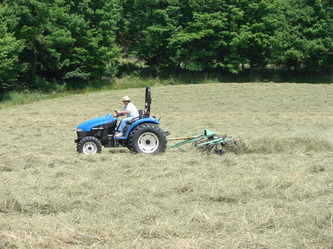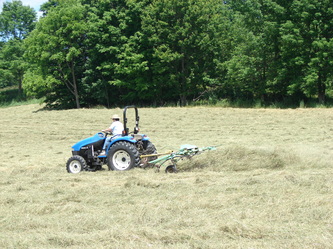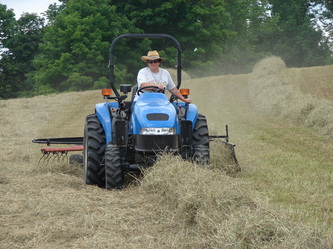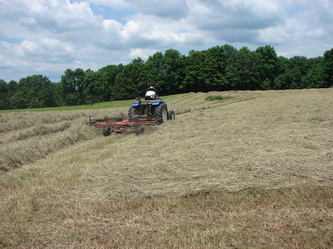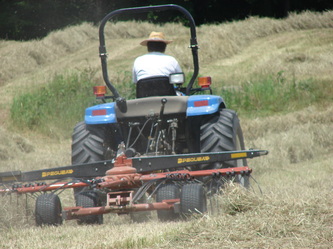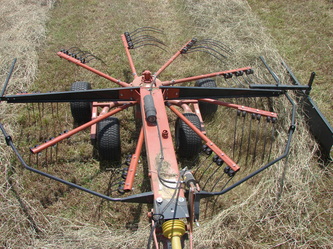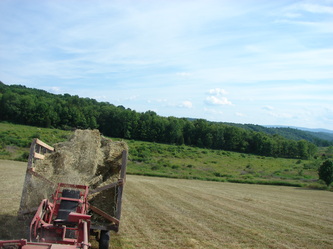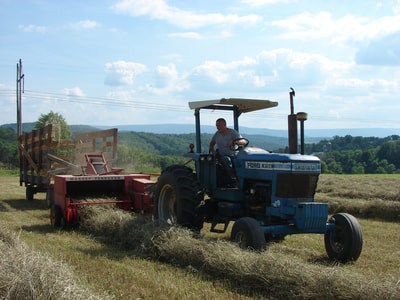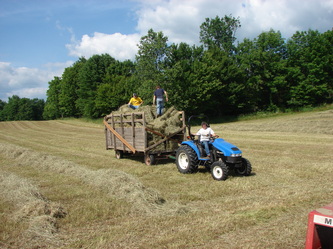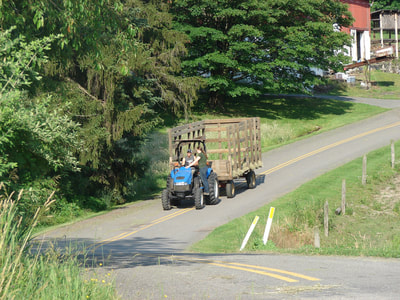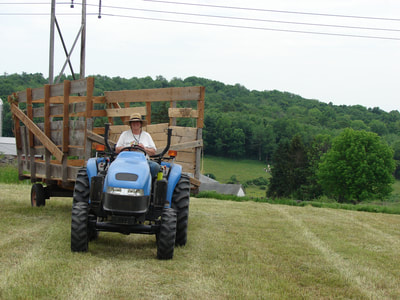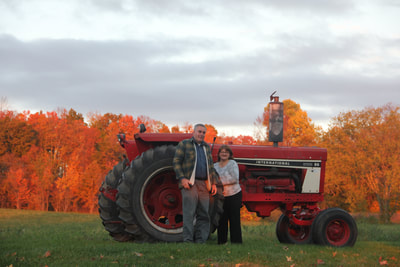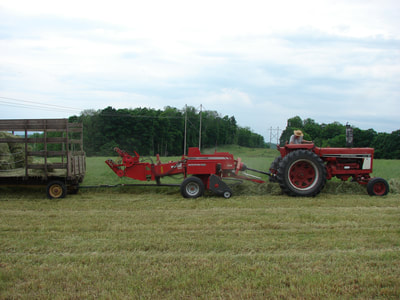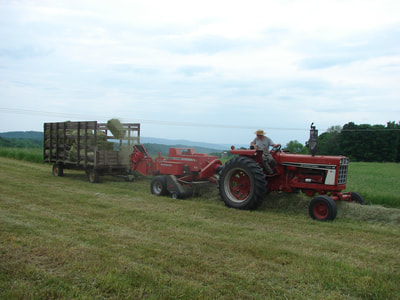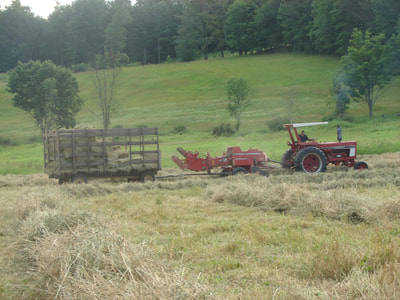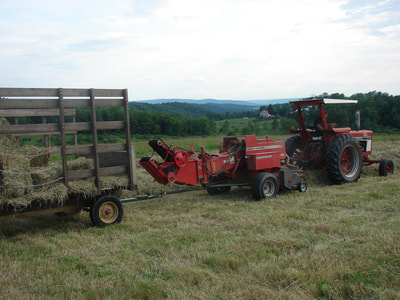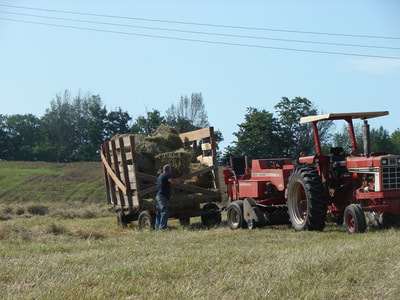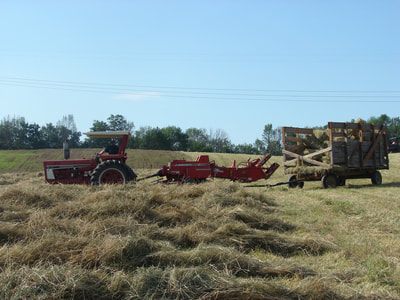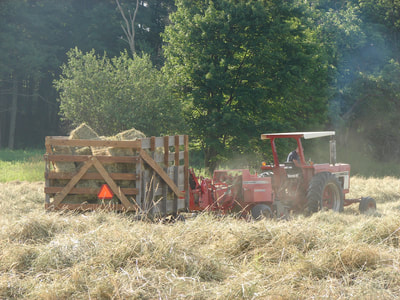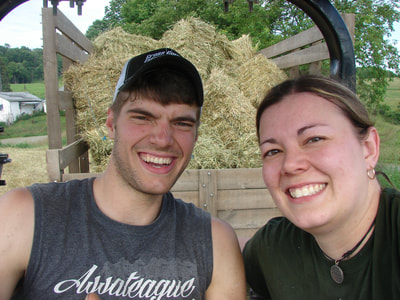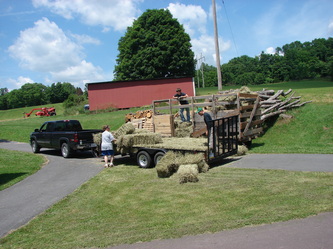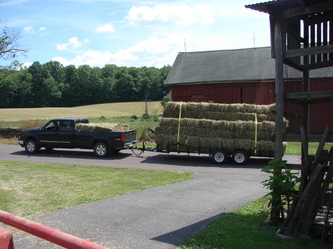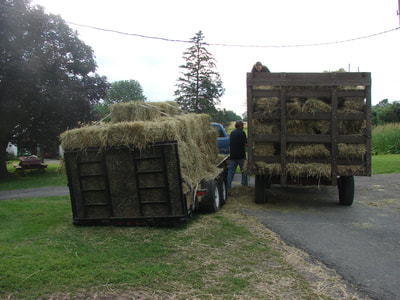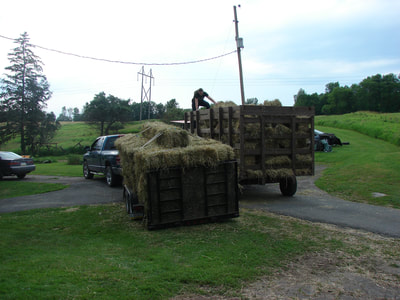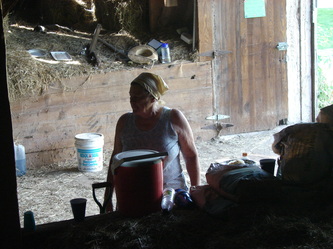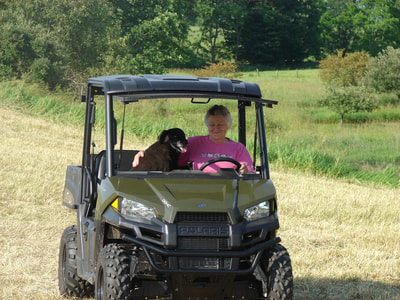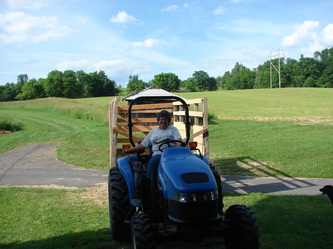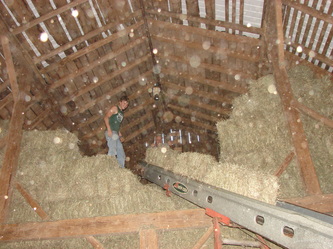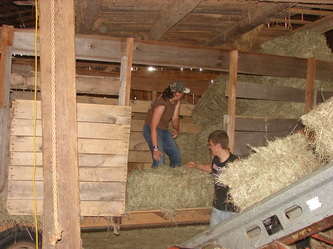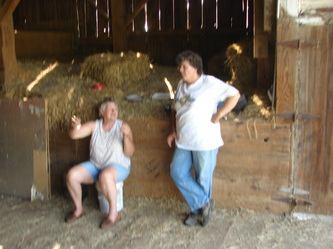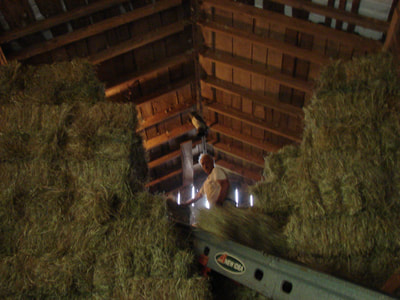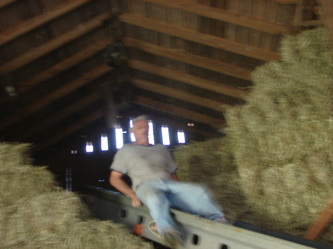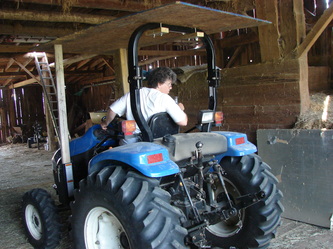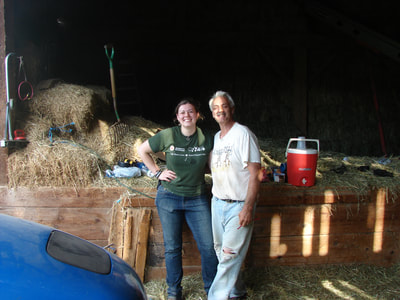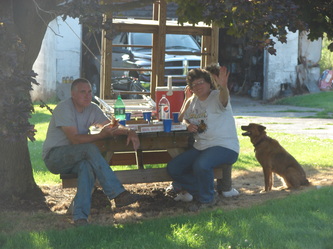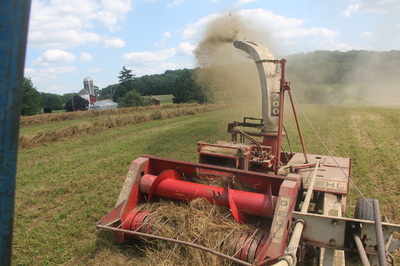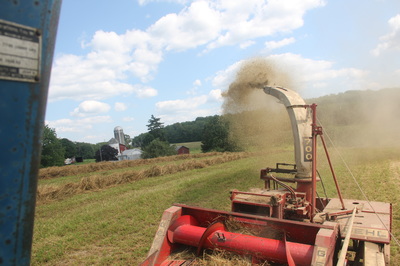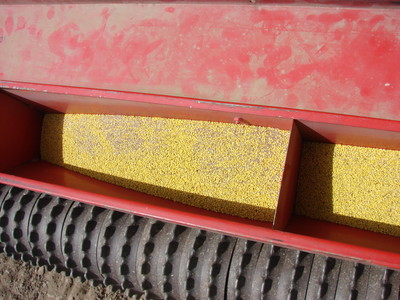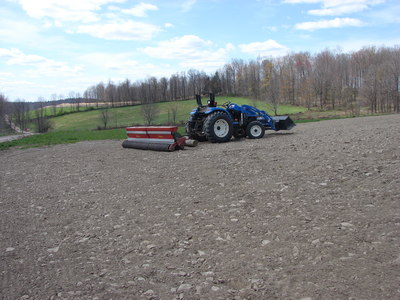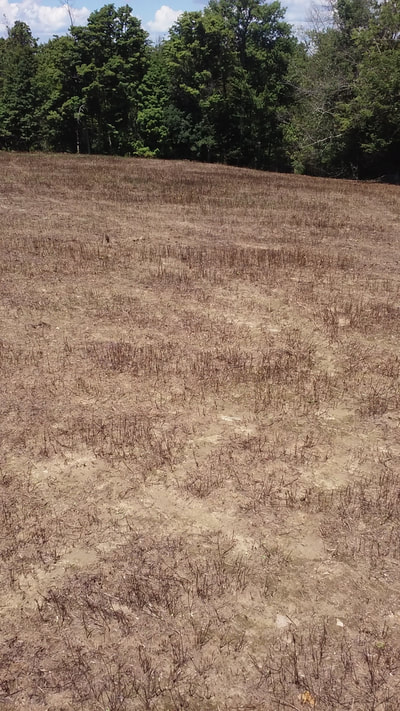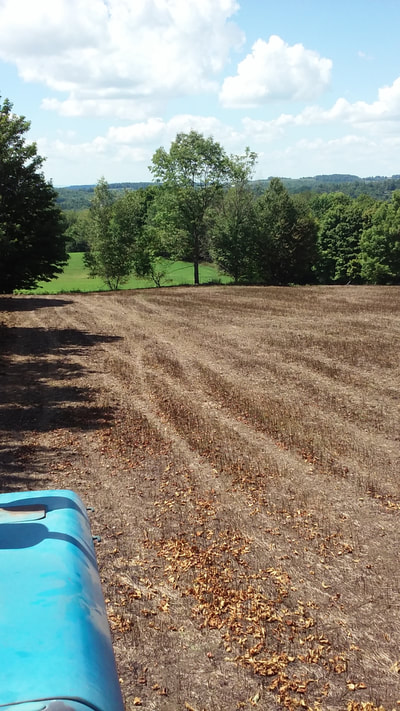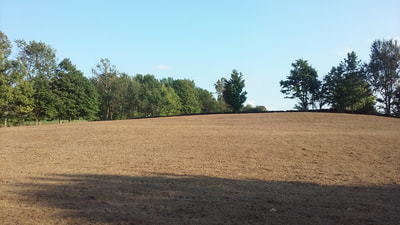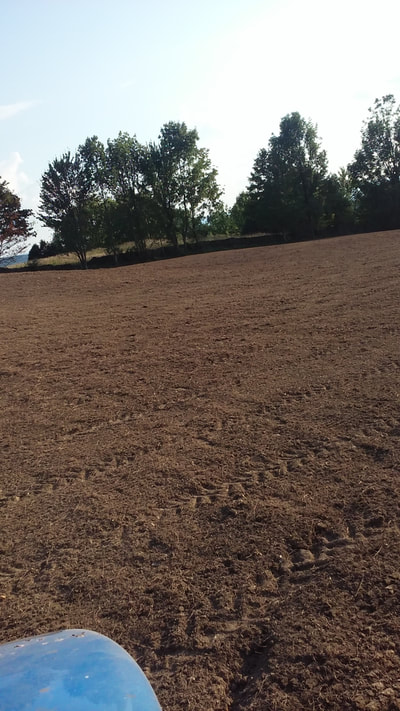Hay!
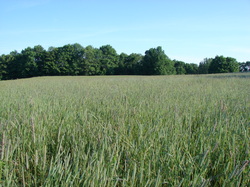
Haying has always been part of our farm. Of course, when our farm was an operating dairy farm, hay was an important feed source for our cows. Now, our hay is mainly sold to local people who have horses.
We take special pride in our hay. Many farms cut and bale fields of what would be best described as "cultivated weeds" but we actually specifically plant varieties of grasses and legumes that make really great hay. Like Dad and Grandpa did before us, we plant a mixture of timothy and alfalfa. We no longer spread manure on the fields since we no longer have cows, but this is a good thing since we have observed that manure re-introduces weed seeds back onto the fields. We also, every few years, rotate a field back into corn for a year or two. This allows us to kill off any weed infestations through the use of herbicides and cultivation. Alfalfa is the preferred legume for horses. Some interesting reading here, here and here.
We have had many comments from horse owners about how their horses love our hay. Dad took a great deal of care and pride in the hay he made and we are continuing that tradition. We could easily get $4 or more per bale if we were selling it in the right markets but we only charge $3.00 /bale for first cutting, $3.50 /bale for second cutting. We offer a discount if you come when we are baling so we don't have to store the hay in our barn. For us, it's more of a fun activity for our families to do - Like the billboard says: "The family that hays together, stays together". Actually it says "prays" but we do that too.
We take special pride in our hay. Many farms cut and bale fields of what would be best described as "cultivated weeds" but we actually specifically plant varieties of grasses and legumes that make really great hay. Like Dad and Grandpa did before us, we plant a mixture of timothy and alfalfa. We no longer spread manure on the fields since we no longer have cows, but this is a good thing since we have observed that manure re-introduces weed seeds back onto the fields. We also, every few years, rotate a field back into corn for a year or two. This allows us to kill off any weed infestations through the use of herbicides and cultivation. Alfalfa is the preferred legume for horses. Some interesting reading here, here and here.
We have had many comments from horse owners about how their horses love our hay. Dad took a great deal of care and pride in the hay he made and we are continuing that tradition. We could easily get $4 or more per bale if we were selling it in the right markets but we only charge $3.00 /bale for first cutting, $3.50 /bale for second cutting. We offer a discount if you come when we are baling so we don't have to store the hay in our barn. For us, it's more of a fun activity for our families to do - Like the billboard says: "The family that hays together, stays together". Actually it says "prays" but we do that too.
Ready to Cut
Many of the common grasses that make up a typical hayfield such as orchard grass and broome grass, mature in mid May. We've found that it is very difficult to make dry baled hay during the month of May which is when those grasses should be harvested. Timothy matures later, typically early to mid June, which is an ideal time to make dry hay. Early to mid June is also when the alfalfa is maturing.
The pictures at the right show our fields with closeups of the timothy and alfalfa. The fields will sometimes have a slight bluish tint to them due to the small purple blossoms on the heads of the timothy. We use a diskbine to cut the hay. This machine cuts the hay and then pulls it between two rollers to condition the hay. This conditioning process squeezes the stems which allow the hay to dry faster. |
|
Preparing to BaleDrying the hay thoroughly is necessary to prevent dust and especially mold. Any rain on cut hay will cause mold to form causing dusty hay which is not good for horses. A light shower or two usually does no harm except maybe to discolor the hay somewhat - and if this happens we will inform any buyers. Any heavier rain usually ruins the hay for horses. If the hay is still acceptable for cattle, we allow our neighbors to round-bale and wrap the hay for their cows. If the hay is ruined by a prolonged period of rain we sometimes end up chopping the hay and blowing it back onto the field just to get rid of it.
To dry the hay we use a tedder to "fluff" the cut wind-rows. We usually wait about 24 hours after the hay is cut before fluffing it with the tedder. We then rake the hay back into wind-rows to bale. We use a rotary rake to rake the hay because we have found that it handles the hay gently and promotes drying even after the hay is raked. Other rakes, notably the pull-behind wheel rake don't allow much drying after the hay is gathered up. The rotary rake sweeps the ground in front of it and gently drops the hay into a row along the side much like a person would do with a pitch fork. |
|
BalingAfter a couple of good sunny days, hay has been tedded and raked and now it's ready to be baled. Most horse owners prefer the traditional square bales and that is what we do. Our baler uses a "kicker" to shoot the freshly made bales into our aging hay wagons. Unless a bale misses going into the wagon (and there's been a lot of that this year for some reason - must be the eyesight of the one driving the tractor) the hay never touches the ground after it's baled.
Our two wagons were originally "convertible" wagon kits from before most of us were born. The wagons could be used as a hay wagon and could be converted into silage wagons during corn chopping season. For the past 4 decades they have been only used as hay wagons and have been repaired and modified so many times that they couldn't be used as a silage wagon even if we had to. One of the wagons was really starting to fall apart so we purchased a newer hay wagon in the summer of 2013. Our wagons are shorter than most wagons simply because the height of our barn doors are shorter than most. The wagons hold about 100 bales. In 2014 we retired our reliable MF124 baler and purchased a demo MF / Hesston 1839 in-line baler. With a hydraulic bale density control and it's in-line hay path it makes bales that are much more consistent as field conditions vary. In 2015 we purchased a lightly used IH Hydro 86 from the Knecht family way out in Iowa and in 2016 added a canopy. It's the perfect setup for bailing hay. We still use the Ford 6700 on the diskbine. The hay is stored in our barn ready for anyone who wants to buy it but sometimes it never makes it to the barn - some people take it right off the wagons as soon as it is baled - "Fresh from the Field" |
|
|
When it rains...
As mentioned above, sometimes we really mess up trying to coordinate with the weather. 2015 was one of those years when weather just didn't cooperate with trying to make dry hay. June turned into July and the hay was starting to get past it's prime. This can pressure folks to take greater chances trying to get the hay made. With the 4th of July upon us and only two fields done, Lee took a chance and cut all of one of our nicest fields of almost pure alfalfa. Cloudy weather and then about five days of rain pretty much ruined it all. We chopped it and blew it back into the field for mulch. |
|
Seeding
When we need to re-plant a field we used to use a traditional moldboard plow, pick rocks, disk, pick more rocks, harrow, pick more rocks and then plant. As you probably guessed, picking rocks is a pretty big part of this process and as we are all getting older it has started to become quite a chore. We have since experimented with a more minimum tillage method. We now will spray a field with roundup three times, usually in May, June, and July. By early August things are pretty dead and sometimes a bit of a controlled field fire helps to clear things off. We then disk the field multiple times which usually minimizes the number of rocks that come to the top. A utility pole drug behind the disk helps to smooth the ground. This prepares the ground nicely for the seeder and we try to get it seeded before Labor Day. |
